Asbestos Exposure
Nearly 250,000 people are killed worldwide from asbestos-related illnesses every year. Asbestos exposure can occur from using certain materials and tools in the workplace, homes, and schools built with asbestos-laden products. Individuals exposed to this harmful mineral are at risk of developing asbestos-related illnesses, including lung cancer and mesothelioma, which can take decades to develop and for symptoms to appear. If you or a loved one has developed an asbestos-related illness, our attorneys can help you get the compensation you deserve.
Home » National Mesothelioma Law Firm » Asbestos Exposure

Legally Reviewed By: Darron E. Berquist
Managing Attorney | Asbestos Litigation
- Page Last Updated:
- May 16, 2025
Legally Reviewed By: Darron Berquist
Managing Attorney | Asbestos Litigation
- Page Last Updated:
- May 16, 2025
Asbestos fibers are invisible to the naked eye. There are no immediate symptoms from inhaling them. Sickness may not emerge until decades later. In the meantime, victims have no way of knowing when they are exposed until they become irreversibly ill.
What Is Asbestos?
Asbestos is a bundle of fibers composed of a group of six silicate minerals that occur naturally on the surface of the earth. These minerals are strong, flexible, odorless, and chemically inert. They do not conduct electricity, and they are resistant to fire and heat. These qualities give asbestos its commercial and industrial appeal.
The six minerals can be divided into two families, based on the type of rock formations from which they are mined: serpentine and amphibole. Asbestos formations are abundant in some states, but no asbestos is mined in the United States today.
The Serpentine Family
Chrysotile asbestos is the sole asbestos type in the serpentine family. It is mined in Canada, Russia and Italy. It has a curly structure and is the most common type used in the United States, accounting for 90 to 95 percent of asbestos in buildings. It is used in the following products:
- Asphalt
- Cement
- Gaskets
- Automobile brake and clutch components
- Plastics
- Roofing Materials
- Rubber
- Textiles
The Amphibole Family
The remaining types of asbestos belong to the amphibole family. These types are ultrafine and needle-like. They are easier to inhale and considered more hazardous than chrysotile asbestos, although all asbestos is hazardous.
Amosite Asbestos
Amosite asbestos is mined in South Africa and is the second most common form of asbestos, present in about five percent of asbestos materials used in buildings in the United States. It has been used in the following products:
- Cement
- Gaskets
- Chemical, electrical and plumbing insulation
- Fire protection
- Roofing
Crocidolite Asbestos
Also known as blue asbestos, crocidolite asbestos is less heat-resistant than other asbestos forms. It is used in cement, tiles and insulation.
Actinolite Asbestos
Actinolite asbestos is a dark-colored asbestos that is comprised of calcium, magnesium, iron and silicon.
Anthophyllite Asbestos
Anthophyllite asbestos is a rare form of asbestos with a brown or yellowish color. It is primarily composed of magnesium and iron. It has mostly been used in cement and insulation materials.
How Does Asbestos Exposure Occur?
Asbestos is not believed to be harmful as long as it remains intact. Asbestos exposure occurs when asbestos is disturbed or damaged. This causes microscopic fibers to be released into the air, where they can be inhaled.
Asbestos was used liberally until the public became aware of its dangers in the late 1970s. Buildings and homes built prior to 1975 almost certainly contain significant quantities of asbestos. Despite its widely known dangers, asbestos is still used commercially today.
How Much Asbestos Exposure Causes Mesothelioma?
The American Cancer Society has observed a loose association between the level of asbestos exposure and the risk of developing mesothelioma. According to the findings, the highest risk comes from high levels of asbestos exposure at an early age over an extended period. Most cases of pleural mesothelioma have been linked to high levels of exposure.
OSHA limits the amount of asbestos a worker can be exposed to during an eight-hour workday to 0.1 fibers per cubic centimeter. While this may seem trivial, OSHA acknowledges that every exposure can cause mesothelioma.
This is confirmed in expert testimony against John Crane, a company known to have exposed workers to asbestos. According to one expert witness, as many as one million asbestos fibers can fit on the head of a pin. Thus, even a single incidence of asbestos exposure could result in millions of fibers being ingested.
According to another expert witness in the same case, even seemingly trivial exposures to asbestos can lead to a mesothelioma diagnosis, and there is no known safe level of exposure. Although the risk of mesothelioma is higher with increased exposure, once the condition develops, the level of exposure does not matter.
Occupations and Products with Risk of Asbestos Exposure
Asbestos use was widespread in the commercial construction, shipbuilding and automotive industries for most of the 20th century. Workers did not use protective measures because they were unaware of the dangers. Historical commercial uses of asbestos include the following:
- Boilers and heating vessels
- Cement pipe
- Automotive components
- Electrical conduits
- Electric motor component
- Laboratory furniture
- Textiles
- Sealants and coatings
- Insulation
- Containers for corrosive chemicals
- Pipe covering
- Paper products

Advertisement for Gold Bond Building Asbestos-Cement Siding
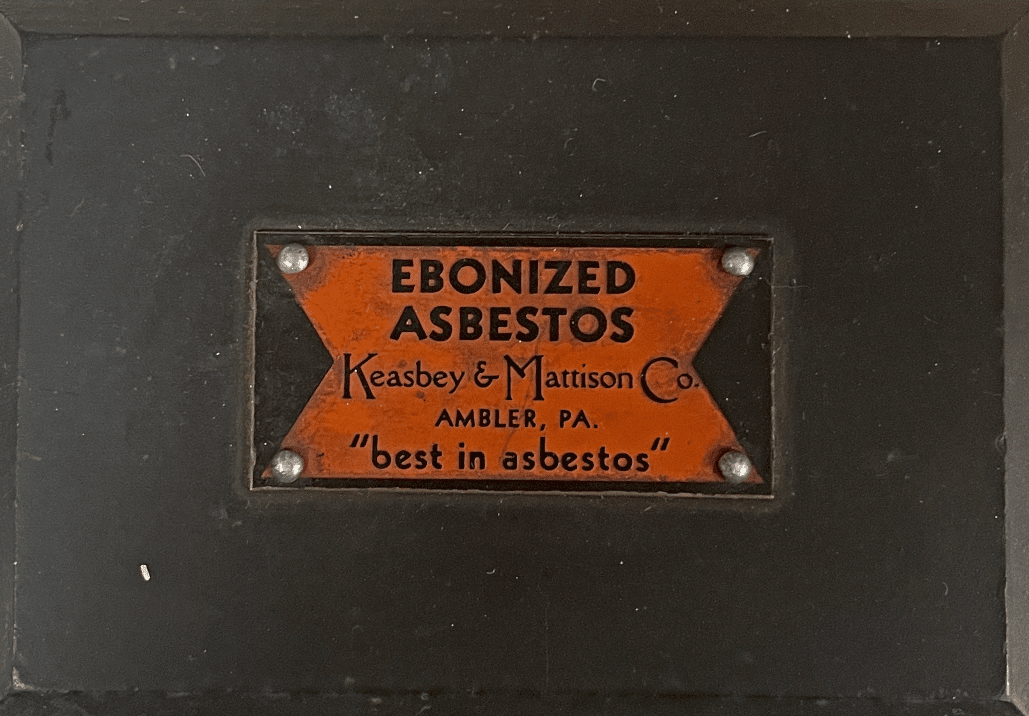
Ebonized Asbestos container label from Keasbey & Mattison Co. the “best in asbestos”
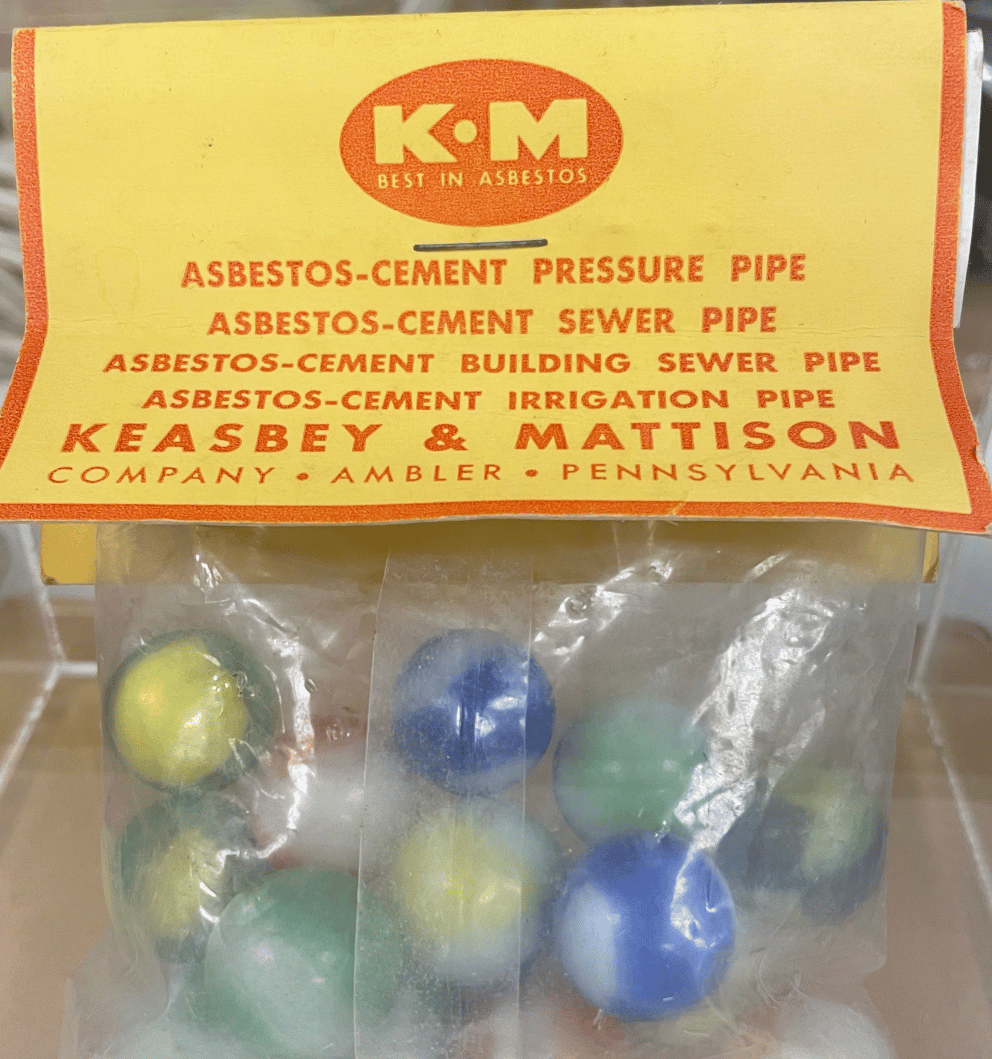
Promotional marbles from Keasbey & Mattison Co. for their asbestos-cement pipes
HVAC Industry Workers
HVAC industry workers face an increased risk of mesothelioma compared to the general population due to asbestos exposure. Asbestos was commonly found in ductwork, insulation, machine gaskets, and other building components related to HVAC systems.
Construction Workers
Construction workers historically experienced the highest risks during construction of older buildings, renovations and demolitions. These activities can disturb asbestos and release its deadly fibers into the air.
Automobile Mechanics
Automobile mechanics who previously worked on brakes, clutches or transmissions have experienced high-level exposure to asbestos and have since become ill with mesothelioma or other asbestos-related diseases.
First Responders
First responders enter buildings that have collapsed or burned down to perform search and rescue or other life-saving duties. These heroic workers include firefighters, police officers and paramedics. Firefighters take on the majority of the risks. According to the National Institute for Occupational Safety and Health (NIOSH), firefighters experience twice the rate of mesothelioma as the general population.
More than 350 firefighters who responded during the immediate aftermath of the 9/11 terrorist attacks have been diagnosed with asbestosis, and more than 400 have been diagnosed with other lung conditions that could be related to asbestos in the World Trade Center.
Secondary Exposure
Many workers who were unaware of their exposure to asbestos brought the hazardous fibers home from work, causing secondary asbestos exposure to their families. The Lanier Law Firm has successfully represented spouses and children who developed mesothelioma through this type of exposure.
Asbestos Exposure in Public and Residential Buildings
The occupants of buildings constructed before 1975, including homes, schools and office buildings, may have been exposed to asbestos.
Homes
Asbestos was widely used in residential construction and could expose families if disturbed. While most of the asbestos was not easily disturbed, asbestos used in textured paints and wall patching compounds could be easily disturbed, endangering the residents. Other common asbestos uses in residential construction include the following:
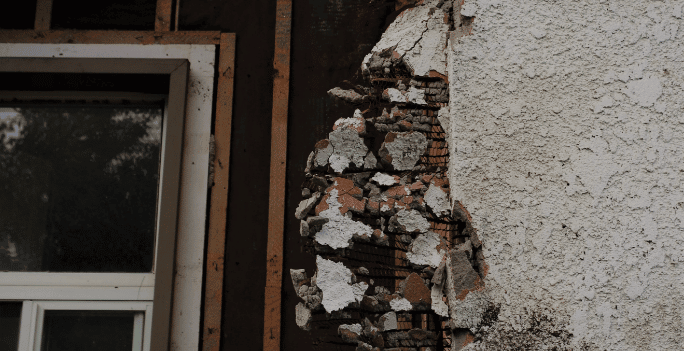
- Caulking and joint compound
- Heat-resistant fabrics
- Insulation around furnaces, hot water pipes, steam pipes and wood-burning stoves
- Ceiling and floor tiles
- Home insulation
- Roofing and siding shingles
Schools
Many schools and universities across the United States are housed in older buildings that contain large quantities of asbestos. The problem is so severe that elementary school teachers are more than twice as likely as the general population to die of mesothelioma.
Although laws have been passed requiring inspections and abatement in the school system, they are not enforced, and schools lack the funding to abate the issue. Multiple investigations have uncovered unsafe levels of asbestos in individual public schools.
Floor tiles manufactured prior to 1981 are presumed to contain asbestos. While undamaged tiles are not a threat, asbestos can be disturbed when they become damaged or begin to deteriorate. Asbestos insulation around water pipes can be damaged or disturbed when pipes leak or burst.
“I think there is a misconception out in the public that if a person is diagnosed with mesothelioma and they immediately think, ‘Well, I’ve never been exposed to asbestos, so therefore I don’t have a claim.’ There are a lot of ways people can be exposed to asbestos and not even know it, either from a take home exposure from a parent bringing it home from work on their clothes or from inadvertently being exposed to it in neighborhoods or at industrial facilities, or whatever the case may be. The fact that they have mesothelioma means they were exposed to asbestos at some point, and they need to call a mesothelioma lawyer and identify how that happened.” – Sam Taylor
Asbestos Exposure in the Military
Members of the U.S. Armed Forces have historically experienced the highest levels of asbestos exposure, and this continues today. Although military veterans comprise less than 10 percent of the population, they account for 30 percent of all mesothelioma cases each year.
Military personnel who serve overseas often encounter buildings in the midst of or shortly after being bombed, burned down or otherwise demolished. These buildings almost always harbor asbestos. Massive quantities of the fibers can be released into the air when buildings are destroyed, and these particles can remain airborne for months.
Military service members faced asbestos exposure through their own equipment or in their own barracks. The military began heavily investing in asbestos in the 1930s due to its low cost and usefulness, and it was commonly used in the construction of barracks.
Military Occupational Asbestos Exposure
Significant exposure also occurred during the course of service member work duties, where U.S. Navy personnel’s asbestos exposure is amongst the highest.
Beginning in the 1930s, the military lined every naval vessel with asbestos. It was also used liberally in the boiler rooms and engine compartments of ships, exposing those who worked below deck in these areas to the largest risks.

U.S. Army, Air Force and Marine personnel experienced high levels of exposure when servicing or maintaining aircraft or other military vehicles. Asbestos was liberally used in vehicle components that were prone to friction, including brake components and clutches.
Overall, the military occupations with the highest risks of asbestos exposure include:
- Mining
- Shipyards
- Carpentry
- Milling
- Construction
- Demolition
Common Products Containing Asbestos
Perhaps one of the most frightening issues surrounding asbestos is that it can be found in everyday products, and there is no means by which to detect it. For years before the dangers were known, asbestos was used in products like household appliances, toys and devices.
As a naturally occurring product, asbestos has been unexpectedly found in other mined products, most notably in vermiculite and talc.
Household Products
Asbestos was commonly used in household appliances manufactured before 1980, including:
- Hair Dryers
- Small kitchen appliances
- Irons
- Portable heaters
It is important to note that the mere presence of asbestos in household appliances is not a cause for alarm. The asbestos was encased within the appliances and was only likely to be disturbed if such appliances were disassembled.
Besides appliances, asbestos has been used in many other products that were manufactured prior to 1980 or imported. Some of these products consist of friable asbestos (asbestos that is airborne or could easily become airborne).
Examples include:
- Chalkboards
- Toys
- Ironing board covers
- Duct Tape
- Vintage fake snow for Christmas trees
- Crayons
- Yarn
- Electric Blankets
- Fireproof products used in and around wood-burning stoves
Asbestos-Contaminated Vermiculite
Vermiculite is a naturally occurring mineral with a flaky structure similar to mica. When heated, it “pops” and expands, becoming a lightweight material. Common uses include soil amendments in gardening and building insulation.
Most vermiculite is asbestos-free, but the vermiculite mined in the small town of Libby, Montana, was found to be contaminated with actinolite and tremolite asbestos. The popping process disturbs the asbestos, causing its microscopic fibers to become airborne and hazardous.
The Libby mine provided up to 80 percent of the world’s vermiculite at its peak, exposing millions of people to asbestos. The mine was shut down in 1990, and in 2009, the EPA declared a public health emergency in the town of Libby, where many residents had become ill.
Asbestos-Contaminated Talc
Talc is a natural silicate mineral that is mined from the ground. Talc is the softest mineral on earth and is valued for its texture and moisture-wicking properties. Due to where talc is mined, it is commonly contaminated with asbestos, especially the tremolite and anthophyllite types.
Talc has been used in cosmetics for more than a century and was formerly the main ingredient in Johnson & Johnson’s Baby Powder. The Lanier Law Firm won a $4.69 billion landmark verdict against Johnson & Johnson on behalf of 22 women in the first-ever trial to connect asbestos-laden talc with ovarian cancer. The company has since ceased using talc in the United States.
Talc is also used in powdered makeup products, such as facial powder, eyeshadow and powdered blush. The cosmetic industry is largely self-policing, with limited oversight from the Federal Drug Administration (FDA).
Although the distribution of asbestos-containing talcum powder products is illegal, the FDA does not require pre-market testing of cosmetics. Some cosmetics companies conduct voluntary testing, but many of these tests are inaccurate. The Environmental Working Group found asbestos in three of 21 cosmetics tested, including a children’s product.
Learn More About
Filing a Mesothelioma Lawsuit
- Are you eligible?
- What is the average settlement?
- How long will it take?
Why Should You Trust the Lanier Law Firm to Handle your Mesothelioma Case?
Diseases Related to Asbestos Exposure
The effects of asbestos exposure are generally not observed until a period of 10 to 40 years has passed, and sometimes longer. This is known as the latency period.
Mesothelioma
Mesothelioma is a rare, aggressive and deadly malignant cancer of the mesothelium, the thin tissue surrounding the lungs and abdominal regions. Mesothelioma is often diagnosed after it has reached the latter stages. Although mesothelioma is incurable, early detection and treatment by an experienced practitioner can improve treatment outcomes.
The three most common types of mesothelioma are pleural, peritoneal and pericardial.
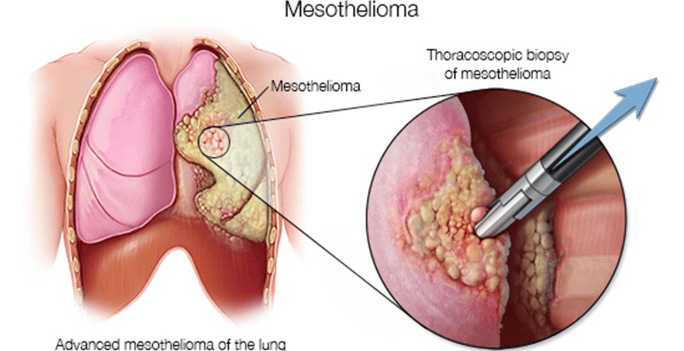
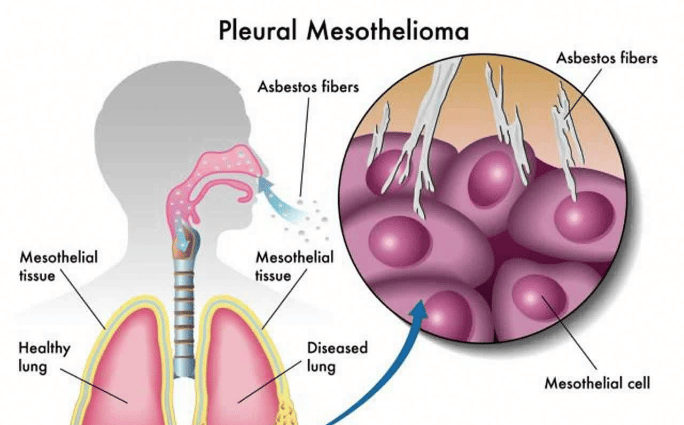
Pleural Mesothelioma
The most common type of mesothelioma, malignant pleural mesothelioma is cancer of the pleura, the tissue surrounding the lungs. Symptoms of pleural mesothelioma include the following:
- Shortness of breath
- Fatigue
- Chest Pain
- Fever
Peritoneal Mesothelioma
Malignant peritoneal mesothelioma is cancer of the stomach lining. The most common symptoms include the following:
- Abnormal bowel movements
- Weight loss
- Abdominal pain or swelling
- Nausea and vomiting
Pericardial Mesothelioma
Malignant pericardial mesothelioma is cancer of the lining of the heart. This type of mesothelioma is less common. Symptoms include the following:
- Chest pain
- Fever or night sweats
- Coughing
- Irregular heartbeat
- Swallowing difficulties

Mesothelioma of Tunica Vaginalis
Also known as testicular mesothelioma, mesothelioma of tunica vaginalis is the rarest type, with only 250 reported cases. Early symptoms include a mass or swelling of the testicles.

Lung Cancer
According to a large 1979 study, asbestos exposure increases the risk of developing lung cancer by five-fold. Tobacco use increases the risk by 10-fold. Tobacco use and asbestos exposure together increased the risk by 50-fold, indicating an ominous synergistic effect. Further studies have resulted in similar findings.
Smoking cessation decreases this added risk. After 30 years of cessation, the added risk is eliminated completely.
Asbestosis
Asbestosis is a painful inflammatory condition that causes scarring of the lungs. The scarred lung tissue does not function in the same manner as healthy tissue, resulting in difficulty breathing. Asbestosis is often, but not always, a precursor to lung cancer.
Ovarian Cancer
Ovarian cancer is a deadly and aggressive cancer that occurs in the ovaries. Ovarian cancer linked to asbestos exposure is most commonly caused by asbestos-laden talcum powder in feminine hygiene products, such as Johnson & Johnson’s Baby Powder. Studies show that women who use these types of products are 30 percent more likely to develop ovarian cancer compared to those who do not use such products.
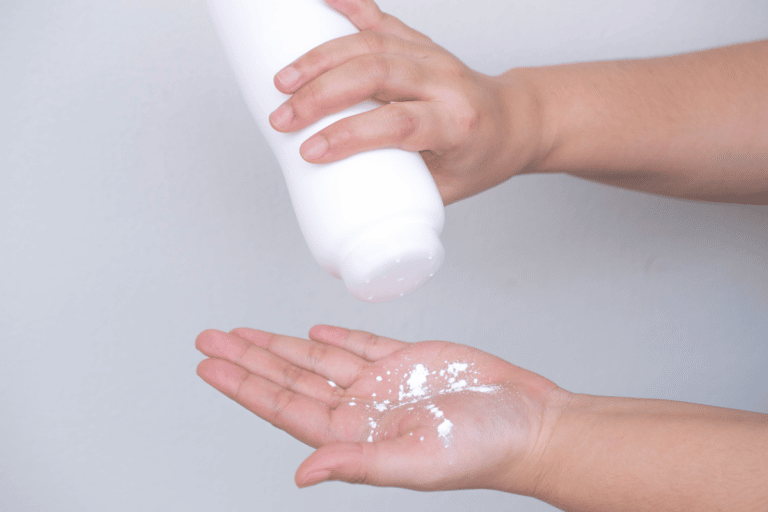
Asbestos Exposure Laws
As the health hazards precipitated by asbestos exposure became apparent throughout the 20th century, the federal government began to establish restrictions on its use. While many state and local governments have established their own restrictions, the majority of asbestos regulations are set by federal agencies.
The Environmental Protection Agency (EPA)
The 1976 Toxic Substances Control Act grants the EPA the authority to regulate toxic substances, including asbestos. This has enabled the EPA to restrict most asbestos uses. The EPA is pushing towards a total ban on asbestos, but this has been an uphill battle due to intense opposition from asbestos companies. In 2024, the EPA implemented a ban on the ongoing use of chrysotile asbestos in the United States.
The Clean Air Act
The EPA implements environmental laws passed by Congress. One of the most important of these is the Clean Air Act, which regulates air toxins, including the release of asbestos fibers into environments where asbestos is handled.
This regulation requires certain procedures to be followed during building demolitions and renovations. These regulations apply to commercial and residential buildings and require the following:
- A thorough inspection by a trained professional (most states require these professionals to be licensed for this purpose)
- Notification of the appropriate state or local agency before the project begins
- Practices that control asbestos emissions:
- Removing asbestos-containing materials (ACM)
- Wetting of the materials
- Proper sealing and disposal of ACM
Asbestos National Emission Standards of Hazardous Air Pollutants (NESHAP), a regulation under The Clean Air Act, requires a trained individual to be present throughout the operation.
The Occupational Safety and Health Administration (OSHA)
The primary responsibility of OSHA is to enforce federal employer safety standards. OSHA enforces asbestos safety regulations in shipyards, construction and general industries to protect workers from occupational exposure to asbestos.
The Consumer Product Safety Commission (CPSC)
The CPSC ensures consumer products meet safety standards. The agency has the authority to regulate asbestos in consumer products and to implement outright bans on such products. For example, the CPSC has banned the use of artificial fireplace embers made of asbestos due to their friability.
Lawyer for Asbestos Exposure - Mesothelioma Compensation
Asbestos-related illnesses such as mesothelioma can be a shocking diagnosis for those who were unaware of having been exposed or who are several decades removed from exposure. These scenarios occur frequently, and the length of time between exposure and illness may create feelings of hopelessness about receiving compensation. To get the mesothelioma compensation you deserve, you want an experienced Lawyer for Asbestos Exposure on your side. The Lanier Law Firm’s asbestos exposure and mesothelioma lawyers are passionate about holding large companies accountable for exposing individuals to asbestos.
Most statutes of limitation for asbestos-related claims begin tolling when the condition is diagnosed rather than when the exposure occurred. While these facts do not guarantee filing claims for compensation will be simple, they should provide hope to the victims that substantial compensation is attainable.
Asbestos manufacturers knowingly exposed workers and the public to asbestos while actively engaging in concealment activities regarding its dangers, making these companies liable. Asbestos exposure victims who have developed asbestos-related illnesses have three potential pathways to recovering compensation. In many cases, victims can recover compensation for asbestos exposure through more than one of these methods.
Asbestos Exposure Trust Fund Claims
Many asbestos manufacturers that were overwhelmed with asbestos lawsuits went bankrupt under Chapter 11 of the U.S. Code and established asbestos trust funds for the benefit of their victims as a required provision under the bankruptcy reorganization. Asbestos victims can file claims for compensation directly through these mesothelioma trust funds.
It is advisable for any trust fund claimant to contact an experienced asbestos law firm to verify eligibility and potentially identify additional sources of exposure. It is not uncommon for claimants to have been exposed through more than one source.
Asbestos Exposure VA Claims
The VA provides monthly disability compensation and free medical care to eligible veterans who become ill as a result of asbestos exposure while in the military. These claims are filed directly through the VA in person, by mail, or through an experienced mesothelioma lawyer. Disability award amounts are based on the degree of disability. The higher the degree of disability, the higher the compensation. Mesothelioma patients are typically rated at 100 percent disability.
Asbestos Litigation
Personal injury lawsuits are an option in cases where one or more asbestos exposure sources is not military-related or bankrupt. Compensation in personal injury cases can include medical expenses, loss of income, pain and suffering, loss of consortium (husbands and wives), loss of society and punitive damages in some jurisdictions. These cases require the representation of experienced mesothelioma attorneys.
Compensation for Surviving Family Members of Asbestos Exposure Victims
Surviving family members can initiate or continue a trust fund claim or file a VA claim for survivors’ benefits. Surviving family members can access many of the same benefits as the living veteran or trust fund claimant.
If litigation is necessary, family members can file a wrongful death lawsuit and receive such damages as medical expenses, funeral and burial expenses, pain and suffering damages, loss of companionship and pecuniary damages (the projected lost income or value of the decedent’s life). Punitive damages may also be available in some cases.
If you or a loved one has been affected by the devastation asbestos exposure can cause, contact The Lanier Law Firm! Our team of asbestos-exposure lawyers will go to any length to protect victims of mesothelioma. We are here to fight for you.
By submitting this form, you agree to our terms & conditions. Please read the full disclaimer




